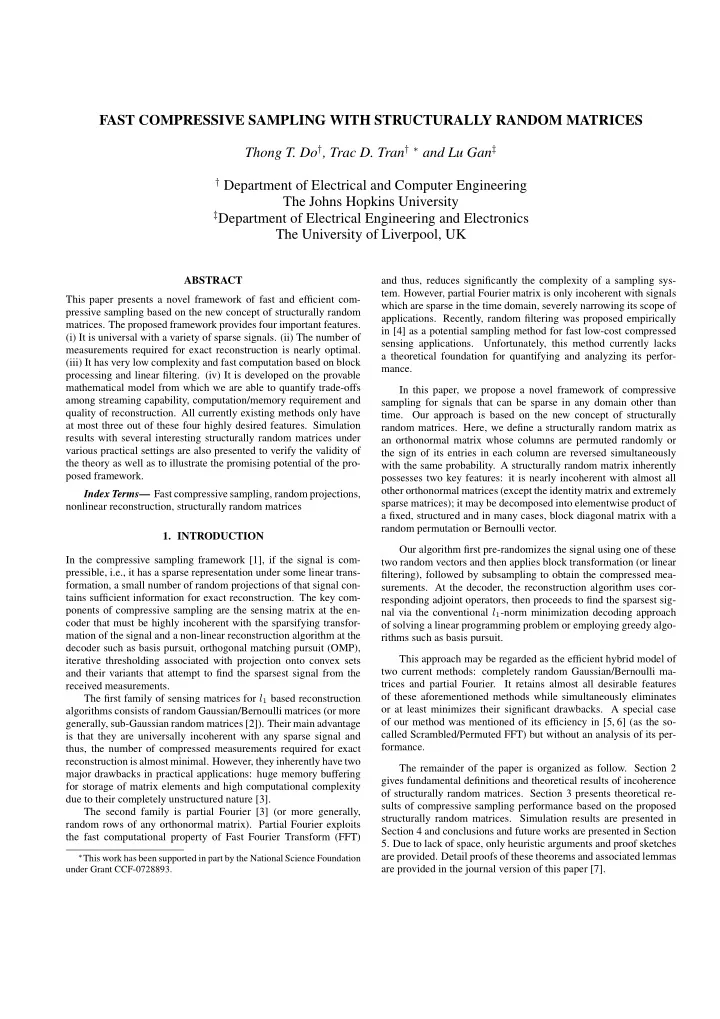

FAST COMPRESSIVE SAMPLING WITH STRUCTURALLY RANDOM MATRICES Thong T. Do † , Trac D. Tran † ∗ and Lu Gan ‡ † Department of Electrical and Computer Engineering The Johns Hopkins University ‡ Department of Electrical Engineering and Electronics The University of Liverpool, UK ABSTRACT and thus, reduces significantly the complexity of a sampling sys- tem. However, partial Fourier matrix is only incoherent with signals This paper presents a novel framework of fast and efficient com- which are sparse in the time domain, severely narrowing its scope of pressive sampling based on the new concept of structurally random applications. Recently, random filtering was proposed empirically matrices. The proposed framework provides four important features. in [4] as a potential sampling method for fast low-cost compressed (i) It is universal with a variety of sparse signals. (ii) The number of sensing applications. Unfortunately, this method currently lacks measurements required for exact reconstruction is nearly optimal. a theoretical foundation for quantifying and analyzing its perfor- (iii) It has very low complexity and fast computation based on block mance. processing and linear filtering. (iv) It is developed on the provable mathematical model from which we are able to quantify trade-offs In this paper, we propose a novel framework of compressive among streaming capability, computation/memory requirement and sampling for signals that can be sparse in any domain other than quality of reconstruction. All currently existing methods only have time. Our approach is based on the new concept of structurally at most three out of these four highly desired features. Simulation random matrices. Here, we define a structurally random matrix as results with several interesting structurally random matrices under an orthonormal matrix whose columns are permuted randomly or various practical settings are also presented to verify the validity of the sign of its entries in each column are reversed simultaneously the theory as well as to illustrate the promising potential of the pro- with the same probability. A structurally random matrix inherently posed framework. possesses two key features: it is nearly incoherent with almost all other orthonormal matrices (except the identity matrix and extremely Index Terms — Fast compressive sampling, random projections, sparse matrices); it may be decomposed into elementwise product of nonlinear reconstruction, structurally random matrices a fixed, structured and in many cases, block diagonal matrix with a random permutation or Bernoulli vector. 1. INTRODUCTION Our algorithm first pre-randomizes the signal using one of these In the compressive sampling framework [1], if the signal is com- two random vectors and then applies block transformation (or linear pressible, i.e., it has a sparse representation under some linear trans- filtering), followed by subsampling to obtain the compressed mea- formation, a small number of random projections of that signal con- surements. At the decoder, the reconstruction algorithm uses cor- tains sufficient information for exact reconstruction. The key com- responding adjoint operators, then proceeds to find the sparsest sig- ponents of compressive sampling are the sensing matrix at the en- nal via the conventional l 1 -norm minimization decoding approach coder that must be highly incoherent with the sparsifying transfor- of solving a linear programming problem or employing greedy algo- mation of the signal and a non-linear reconstruction algorithm at the rithms such as basis pursuit. decoder such as basis pursuit, orthogonal matching pursuit (OMP), This approach may be regarded as the efficient hybrid model of iterative thresholding associated with projection onto convex sets two current methods: completely random Gaussian/Bernoulli ma- and their variants that attempt to find the sparsest signal from the trices and partial Fourier. It retains almost all desirable features received measurements. of these aforementioned methods while simultaneously eliminates The first family of sensing matrices for l 1 based reconstruction or at least minimizes their significant drawbacks. A special case algorithms consists of random Gaussian/Bernoulli matrices (or more of our method was mentioned of its efficiency in [5, 6] (as the so- generally, sub-Gaussian random matrices [2]). Their main advantage called Scrambled/Permuted FFT) but without an analysis of its per- is that they are universally incoherent with any sparse signal and formance. thus, the number of compressed measurements required for exact reconstruction is almost minimal. However, they inherently have two The remainder of the paper is organized as follow. Section 2 major drawbacks in practical applications: huge memory buffering gives fundamental definitions and theoretical results of incoherence for storage of matrix elements and high computational complexity of structurally random matrices. Section 3 presents theoretical re- due to their completely unstructured nature [3]. sults of compressive sampling performance based on the proposed The second family is partial Fourier [3] (or more generally, structurally random matrices. Simulation results are presented in random rows of any orthonormal matrix). Partial Fourier exploits Section 4 and conclusions and future works are presented in Section the fast computational property of Fast Fourier Transform (FFT) 5. Due to lack of space, only heuristic arguments and proof sketches are provided. Detail proofs of these theorems and associated lemmas ∗ This work has been supported in part by the National Science Foundation are provided in the journal version of this paper [7]. under Grant CCF-0728893.
Recommend
More recommend